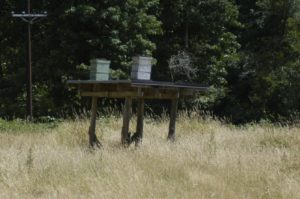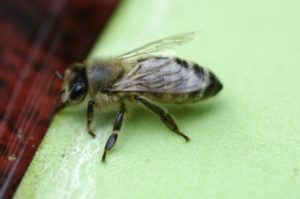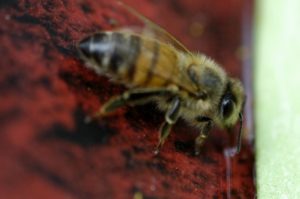Willamette Valley Beekeepers Association (WVBA) Established in 1967.

Our next meeting on Monday the 24th of August at 7 p.m. will be in Building 9, Room 111 at Chemeketa. Plan to bring your questions for a round table session. Todd and Trevor are going to show the 18 minute video that is going to play at the State Fair Bee Booth. We will also talk about storing supers and getting your bees ready for winter.
Every one in attendance enjoyed a fine picnic last month at the Oak Creek Center for Urban Horticulture at OSU. We had great weather and wonderful food. Market of Choice in Corvallis did a great job on the chicken again this year. Thank you to OSU, the folks who brought great food, and to those who donated door prizes. Those in attendance got to watch me get stung in the side of the nose.

Hopefully everyone has their honey supers off of their hives. It’s that time of year to deal with varroa and tracheal mites. First off it’s always best to take a varroa mite sample and see how critical the mite load is. You can test using the powered sugar shake or the alcohol wash. I prefer the alcohol wash, since the claim is that it’s a bit more accurate. If the alcohol wash indicates 2% or less ( 6 mites on 300 bees) you may decide not to treat that hive. If the test reveals more mites than that, then the beekeeper should treat the hive to reduce the varroa mite load. Don’t forget about tracheal mites. Lately word is being spread around that the bees will take care of the tracheal mites themselves. The honeybees will not take care of them. A hive can easily die from too many tracheal mites and the viruses that they carry. The reason for such an early mite treatment, is to get the honeybees ready for winter. The idea is to start producing as many healthy-mite free bees as possible. To succeed in this, it is suggested that you feed syrup and pollen patties. We feed a 1:1 syrup; even in the fall. These healthy bees will then be the honeybees that produce the winter bees which hopefully will be mite-free. After any mite treatment is over the beekeeper may want to treat for American foulbrood (AFB). AFB has been more prevalent in the last few years.
Have you signed up to work the Oregon State Fair Bee Booth? This is a great time and opportunity to promote honeybees. Don’t worry if you are thinking that you don’t know enough about bees; if you have been a beekeeper for a part of a year, you know more than the general public. You’ll meet many interesting people.
The Oregon State Beekeepers Association (OSBA) Fall Conference is coming up on Nov. 6,7,and 8, 2015. It’s being held at the Oregon Garden Resort in Silverton. This year’s theme for the conference is “Products of the Hive.” For more information go to www.orsba.org. It is being held here in the valley so plan to attend and add to your beekeeping knowledge.

The documentary Queen of the Sun: What are the Bees Telling Us? is going to play at the Wilsonville Public Library, August 26th at 7 p.m. The library is at 8200 SW Wilsonville Rd., Wilsonville, OR.
Cheers, Rich
